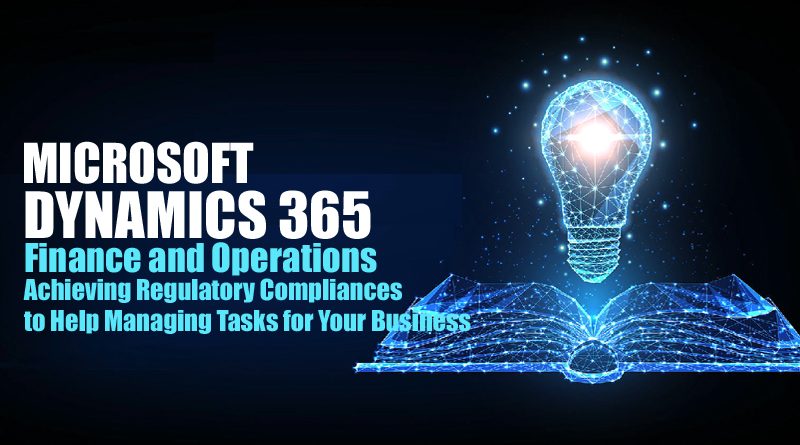Achieve Regulatory Compliance with Microsoft Dynamics 365 Finance and Operations
Organizations must manage regulatory compliance efficiently to avoid legal issues, penalties, and reputational damage. Regulatory compliance refers to adhering to laws, regulations, and standards that govern an organization’s operations. These regulations can be industry-specific or related to financial and tax compliance. Failure to comply with these regulations can result in severe consequences, including hefty fines, legal action, and reputational damage. However, with the increasing number of rules and regulations, staying on top of them can take time. Fortunately, Microsoft Dynamics 365 Finance and Operations provides the tools needed to help organizations with this task.
Microsoft Dynamics 365 Finance and Operations is an enterprise resource planning (ERP) system that provides organizations with a comprehensive suite of financial and operational functions. It helps organizations streamline business processes, manage financial operations, and optimize supply chain management. Additionally, Dynamics 365 Finance and Operations provides robust compliance features ensuring organizations meet regulatory requirements.
Also Read:
Steps to Achieve Regulatory Compliance with Dynamics 365 Finance and Operations
Organizations can follow certain steps to achieve regulatory compliance with Dynamics 365 Finance and Operations, which include:
Identify Regulatory Requirements:
The first step in achieving regulatory compliance is to identify the relevant regulations that apply to the organization. This involves understanding industry-specific regulations, financial regulations, tax regulations, and other applicable laws.
Map Regulatory Requirements to Business Processes:
Once the regulatory requirements have been identified, the next step is to map them to the organization’s business processes. This helps identify gaps in compliance and ensures that the organization complies with all applicable regulations.
Configure Dynamics 365 Finance and Operations:
After identifying the regulatory requirements and mapping them to business processes, the next step is configuring Dynamics 365 Finance and Operations to meet compliance needs. This involves setting up compliance features like audit trails, access controls, and approval workflows.
Monitor Compliance:
Compliance is an ongoing process that requires continuous monitoring and management. Dynamics 365 Finance and Operations provides tools to monitor compliance, including reports and dashboards that provide real-time insights into compliance status.
Implement Controls and Remediation:
If compliance gaps are identified, organizations need to implement controls and remediation measures to address them. Dynamics 365 Finance and Operations provides tools to implement controls, such as segregation of duties, remediation measures and corrective action plans.
Also Read:
- Corporate Tax for UAE Businesses – Insights for Entrepreneurs
- Top-Notch Executive Coaching Services in Dubai
How does D365 Finance and Operations help?
Dynamics 365 Finance and Operations contains certain powerful features that empower organizations to meet their compliance goals, such as:
Audit Trails
One of the key features of Dynamics 365 Finance and Operations is its ability to create comprehensive audit trails for all transactions and activities within the system. This includes changes to master data, creation and approval of transactions, and other important activities.
Audit trails are essential for meeting regulatory compliance because they provide a detailed record of all activities within the system. This helps organizations monitor compliance and provides evidence of compliance to regulatory bodies. In addition, audit trails can help organizations identify any unauthorized or fraudulent activities and take appropriate corrective action.
Segregation of Duties
Another key feature of Dynamics 365 Finance and Operations is its ability to enforce the segregation of duties. Duty segregation is an important component of regulatory compliance because it helps prevent fraud and errors by ensuring that no one person has complete control over a process or transaction.
For example, in financial accounting, it is important to ensure that the person who creates a transaction differs from the person who approves it. Dynamics 365 Finance and Operations can enforce these rules to maintain the segregation of duties.
Access Controls
Dynamics 365 Finance and Operations provides robust access control features that help organizations ensure that only authorized employees have access to sensitive data. Access controls are important for meeting regulatory compliance because they help prevent unauthorized access to data and ensure compliance with data privacy regulations.
Approval Workflows
Dynamics 365 Finance and Operations provide approval workflows that ensure that transactions are approved by authorized personnel before being processed. This helps to prevent errors and fraud and ensures compliance with financial regulations.
Compliance Reporting
Dynamics 365 Finance and Operations provides compliance reporting features allowing organizations to generate compliance reports quickly and easily. This helps organizations monitor compliance and provides evidence of it to regulatory bodies.
Regulatory reporting
Dynamics 365 Finance and Operations provides regulatory reporting features that help organizations comply with financial and tax regulations. These features include pre-built reports that comply with Generally Accepted Accounting Principles (GAAP) and International Financial Reporting Standards (IFRS) regulations.
Also Checkout:
- 5 Best Bookkeeping Services in Dubai
- 8 Main Benefits of Outsourcing Accounting Services in Dubai
- Best 5 Advantages of Internal Auditing to Help Your Business
- How Invoice Template Is An Ideal Step For Small Businesses?
In a nutshell
In summary, Microsoft Dynamics 365 Finance and Operations helps organizations meet regulatory compliance by providing robust audit trails, enforcing segregation of duties, providing access controls, implementing approval workflows, and generating compliance reports. These features help organizations comply with regulatory requirements, minimize compliance risks, and avoid penalties and fines.





